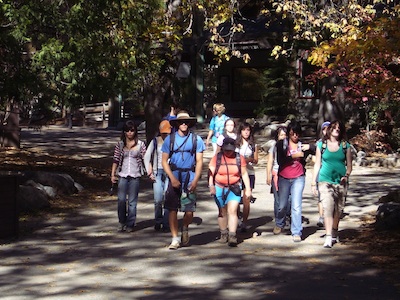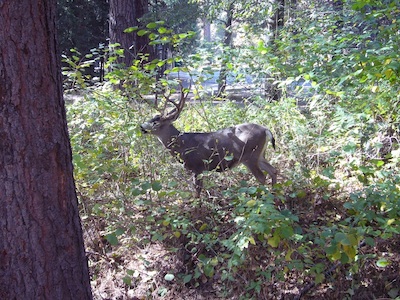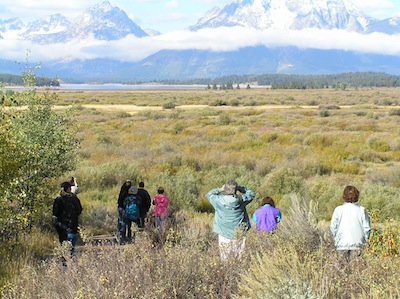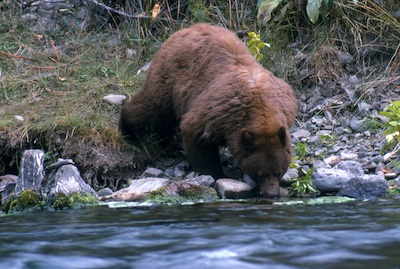
Visitors have impact on ecosystems
Something as innocent as keeping tree leaves, flowers or even small rocks as natural souvenirs can bring harm and significant consequences to a park’s environment, even to the extent of upending nature’s balance.
It might seem like visitors help parks progress and persist and thus removing a flower or feeding a bear would carry insignificant consequences.
However, human visitors not only bring popularity and income to national parks, but also a tremendous impact to their ecosystems.
| Click on the video at the right to view an audio slideshow about human impact on national parks prepared and narrated by writer Donatella Vacca. |
Although national parks work with organizations that deal with their preservation and restoration, with more than 280 million visitors each year, it is clear that the vegetation, animals and environment do suffer due to the effects of human presence within their habitat.
Simple things like yelling or standing and walking on forbidden ground can deteriorate natural habitats and scare and harm animals. This is something that can happen anywhere, but many visitors are unaware of the problem.
Jason Brengle, ecologist and Vegetation Program manager of Grand Teton National Park in Wyoming, believes that humans do cause damage to park resources such as vegetation, wildlife and even human cultural. However, he believes in most cases it is unwilling.
“With the large numbers of visitors to Grand Teton National Park, it is hard to prevent some level of impact. But I believe that most of the times people are unaware of their influences,” said Brengle.
Kari Cobb, spokesperson and ranger at Yosemite National Park, also believes parks and their native species undergo stressful effects due to the impact of human presence.
“Though Yosemite Valley is the most impacted part of Yosemite National Park, other less visited areas do receive impact by visitors too,” added Cobb.
 |
Visitors walk through the Visitor Center area in Yosemite Valley and Yosemite National Park (Staff photo). |
Although the impacts and consequences are not intentional, they still put the parks and their species at risk, dealing with issues that range in severity.
According to the National Park Conservation Association, the impacts can be small concerns caused by the actual presence of people in parks or larger and more complicated issues like air and water pollution, some of the most dangerous threats to parks.
These threats can either be directly caused by humans, or indirectly sparked by the effects of human development and civilization.
For instance, consequences might range from the disturbance and retreat of animals due to invasive visitors, to noise pollution due to nearby highways and airports.
“One would assume that the large numbers of automobiles traveling through the park would have an effect on air quality and since the park has a commercial airport within its boundary, the air is put at a larger risk,” explained Brengle.
“Roads, parking lots, hotels, airports, campgrounds and all the other infrastructure required to support human activity in a national park brings long-lasting impacts to the ecosystem too,” he added.
| Deer graze near Yosemite Lodge at the Falls, an area of dense human visitation at in Yosemite Valley and Yosemite National Park (Staff photo). |  |
According to Brengle some of the impacts Grand Teton National Park endures are also directly related to visitors’ actions.
Grand Teton deals with some examples of trampled vegetation, exotic non-native species accidentally introduced by visitors, the habituation of wildlife to human foods and human presence and the damaging of archaeological sites.
Park rangers believe that the introduction of exotic species into an ecosystem can cause irreparable damage and drastically alter the ecosystem’s function.
Introduced species tend to displace originally native plants and animals. Introduction of aquatic invasive species can turn watersheds into sterile wastelands, resulting in the consumption of all available food while disrupting the natural food chain.
“Habituating wildlife to human activity and foods can cause the animal to become unafraid of people which usually leads to human/wildlife conflicts and at times the animal has to be euthanized,” explained Brengle.
Something that is even more upsetting is the fact that wild animals are frequently hit and killed within park roads, due to the shock that vehicle lights and noises have over them. However, in some cases the accidents are simply caused by distracted drivers too.
Park Ranger Cobb also explained that impacts on Yosemite are more connected to the direct actions of visitors within the park as well.
 |
At left, visitors enjoy the mountain vistas at Willow Flats at Grand Teton National Park in Wyoming. Below, a black bear takes a drink in a wooded area in Grand Teton National Park. (Photos courtesy of the National Park Service). |
“Some vehicles park along the roadways and slightly off the road, and what this does is that it encroaches on some of the nearby vegetation. If this keeps happening day by day, then the local vegetation will face perpetual transformations,” stated Cobb.
She also explained that rangers deal with problems of trail cutting, in which people do not follow the marked trails and instead cut through the middle while stepping on vulnerable plants and grounds.
“In the past we’ve actually had problems with too many people going out into the meadows. All this damage is unintentional, but when you have such a big number of people there is always going to be some kind of impact whether dangerous or manageable,” Cobb said.
The meadows are known as very sensitive areas, and when people go out there they create informal trails and this changes some of the hydrology of the meadow and its ecosystem.
Cobb also added that parks usually deal with problems of people petting or feeding wild animals like deer or squirrels. Even though this might seem like a harmless action, it is in fact very harmful. Human interaction with wild animals can end in violence or else can disrupt the attitude and mood of the animals’ behavior.
However, she also states that when animals retreat to more silent areas they do it not only due to human presence, but by instinct and by the fact that upper areas of the park are usually warmer and more enjoyable.
Even though all these threats are imminent in every national park, these organizations have developed management strategies, laws and plans that help either prevent these impacts or solve their consequences in the most ecological way.
“The park constantly strives to provide education and continually implements new measures to protect resources. We have a large re-vegetation and exotic plant crew that works to restore impacted areas,” clarified Brengle.
Some solutions and entities that help fight the human impact are things like educational signs, interpretive educational programs, fencings to delineate trails or natural areas, the establishing of limitations to human movement within the park and the “Wildlife Brigade” that works to prevent wildlife/human conflicts and educates the public.
 In this case, Yosemite National Park counts with several projects and implemented ideas that battle the impact of human presence.
In this case, Yosemite National Park counts with several projects and implemented ideas that battle the impact of human presence.
“We have several educational programs to bring awareness to the people. We have a really robust program for example that teaches people how to store their food in order to avoid poisoning or harming bears,” said Cobb.
Cobb explained that there are trail crews that mitigate the crosscutting of trails by laying down trees and debris across the middle section of the paths so that people can’t go off the trail and thus harm the plants.
To reduce parking off paved roads, rangers have installed curbing as well as laid big boulders along the road as a way of mitigating excessive parking on raw natural areas.
“We’ve also built boardwalks above the meadows so that visitors can actually go out into these areas without severely impacting them,” added Cobb.
Clearly each national park works with professionals that are on a constant lookout for solutions to the effects of the interaction between man and wilderness.
Brengle expressed that one of the most significant impacts that most visitors do not recognize is the huge human infrastructure placed within a national park to support visitor use.
“This can cause habitat fragmentation, pollution and disruption of ecosystem function. But without this infrastructure it would be much more difficult for humans to visit and enjoy these national parks,” he debated.
Cobb agreed that if Yosemite was an uninhabited region then animals and plants would live in peace.
“But once again we have all this infrastructure that allows the park to exist…we need to cooperate with each other,” she explained.
“The challenge is to protect these places, keep them wild and untrammeled while still allowing the public to visit and enjoy them,” Brengle concluded.

Comments are Closed